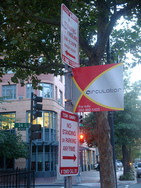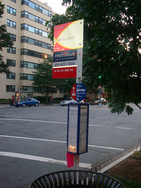Communication problems accompany Circulator changes
Yesterday, the “Blue Bus” between Rosslyn, Georgetown, and Dupont became the District’s newest Circulator line. DDOT also decided to make some routing changes to existing lines at the same time. Unfortunately, there has been little communication of these changes.
With the new service running along M Street in Georgetown, DDOT decided to reroute the westbound Georgetown-Union Station buses along lower K Street to Wisconsin Avenue, which is actually the alignment from the original Circulator proposal.
Eastbound buses keep the same route along M Street and Pennsylvania. Westbound service is discontinued at 3 stops, while another two would no longer have service heading north on Wisconsin, only west to Rosslyn. This is no “small system change,” as DDOT refers to it (scroll to the bottom below the route map).
DDOT has been negotiating this takeover for nearly a year. Yet when it came to implementation on Sunday, the department seemed anything but ready. As of Saturday, there was no communication at the stops or in the buses about the new service changes. Some places in Georgetown had signs noting the switch of the Blue Bus to a Circulator Route, but lacked any notice about changes in the other route.
Furthermore, DDOT had plenty of time to solicit input on the new route and changes to Georgetown-Union Station route that would result. But they didn’t. What happened and why has there been such a lack of communication from a government agency that has generally done a stellar job reaching out to the public?
Last week there was a brief outreach campaign centered around various websites and blogs notifying riders that the Blue Bus would become a Circulator. Some of these articles included the Georgetown-Union Station route changes as a footnote, while others failed to mention it altogether. The DDOT press release falls into the former category.
Today when DDOT tweeted a reminder about the new route but failed to put a “.” in front of @DCCirculator, meaning only followers of DDOTDC who also follow DCCirculator will have seen the tweet. In fairness to DDOT, Twitter doesn’t make this behavior very discoverable and many people aren’t aware of it.
Meanwhile, there is no indication of the route changes on the actual Circulator website. DDOT added the new Rosslyn-Georgetown-Dupont route to DCCirculator.com under the individual route list, but as of this writing, the system map had neither any of the Georgetown-Union Station route changes nor the new route marked on it. The last post under “Latest News” is for a June 28th service change. The Circulator mobile site has neither the new route nor the new changes on the other routes.
DDOT posted new Circulator stop flags along M and L streets for the Dupont Circle-Georgetown segment of the new route, yet didn’t remove the stop flags from the three stops on Pennsylvania where there would no longer be any Circulator service. As of Monday evening, this was the only notice at Penn and 24th that the Circulator no longer stopped there:
Can’t see it? It’s the small piece of paper taped to the front of the schedule holder. From the sidewalk, it practically unnoticeable despite its bright pink color. To read it you actually have to step into the street. Even if you do read it, it doesn’t offer any advice about a rider’s alternatives.
Now that you’ve told me my bus stop is no longer served, the next thing you should tell me is my next best option. Tell riders that they can take a 32, 34 or 36 — but make sure to notify them it will cost $0.50 more — or tell them they can walk to 22nd and Pennsylvania to catch the Wisconsin-bound route.
At an agency that has so meticulously groomed its branding and communication styles, where are the official fliers, the planned outreach? For all we know even, these pink papers were printed by a fellow rider who was frustrated by the lack of communication. What happened?



